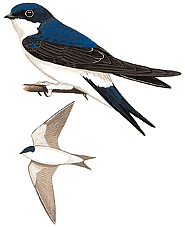|
|
| Main |
| Systematic List |
| Photo |
| Central Siberia |
| Guest book |
| Awards |
| SEARCH |
|---|
|
|
Hirundinidae |
|---|
House Martin Delichon urbica (Linnaeus, 1758)
|
 While the greater part of the distribution of this widespread Palearctic species lies further to the north than that of the Swallow, House Martins are almost unknown from regions north of their normal breeding range. The House Martin is found from the southern edge of Central Siberia north along the Yenisey River and in eastern Taymyr to approximately 70° N. Below 70° on the Yenisey bay, the species occurs as a rare breeder with 0.1-0.3 birds/km2 (Ravkin and Gleich 1981). Further south, in all settlements of the Turukhansk Territory north beyond Dudinka (69°30' N), it is a common breeder (Tugarinov and Buturlin 1911). Middendorff (1869) observed this species in Taymyr near 70° N. It has also been found in the Putorana Mountains breeding in distinct colonies on cliffs along the banks of the Rybnaya and Khantayka Rivers as well as in Norilsk (Krechmar 1966). In the east, Volkov (1987) discovered it on the upper reaches of the Anabar River north almost to 70° N within northern open forests as a numerous breeder (up to 41 birds/km2) on riverbank rock faces. House Martins are widely distributed throughout Evenkia, both in mid and northern taiga, breeding preferentially in suitable natural habitats — rocky river banks — rather than in populated areas. Colonies vary in size from 10 to 50 birds in the northern Evenkian taiga (Volkov 1988). In the southern taiga along the Angara and Kamenka Rivers we came across House Martin colonies with up to 200 pairs, while in the southern part of the region, in the Sayan Mountains, colonies of up to 300-400 pairs were not rare. In Yenisey mid taiga, House Martins selectively breed on the Osinovo Cliffs and in the villages of Podkamennaya Tunguska, Bakhta, Verkhne-Imbatskoye, and Alinskoye. Why precisely these settlements are chosen is not clear. The species was breeding annually, although in low numbers, in Bakhta at the end of the 1970's. In Verkhne-Imbatskoye in 1978, most of the occupied nests were under the roof of a single warehouse. Thirty-six of a total of 50 nests found in the uninhabited settlement of Alinskoye were located on the abandoned store. Martins occupied other buildings in groups of 2-6 pairs, often building their nests directly next to each other so that a single window might have a series of several nests above it. Occasionally, House Martins occupy burrows dug by Sand Martins in vertical clay banks. The species does not nest in Mirnoye, although birds pass through the station almost every spring between May 23 and June 2 and often inspect the roofs and windows of buildings. |
[Back] |
|
|
|
|
Сайт разработан и поддерживается кафедрой прикладной экологии и ресурсоведения СФУ
